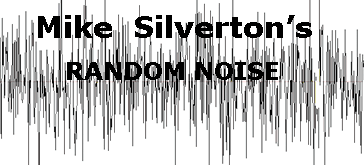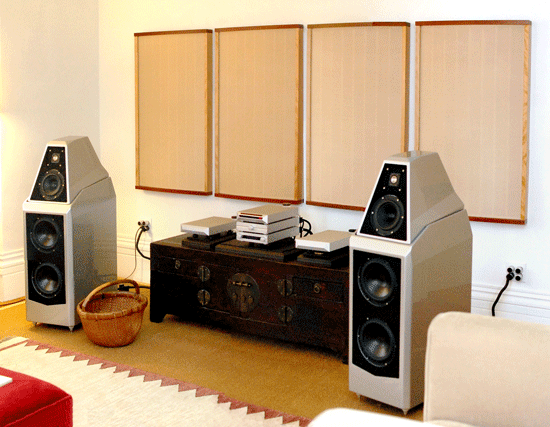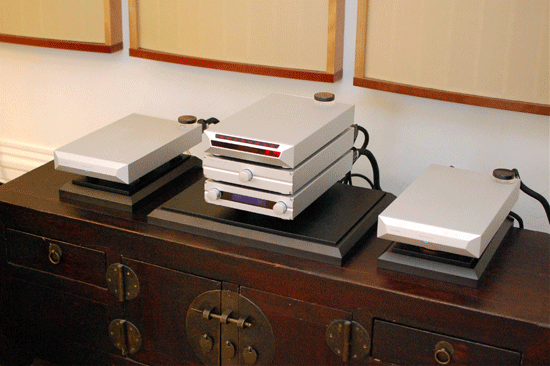Random Noise 23
|
Wilson Audio’s Sasha W/P Loudspeaker Crossing the threshold The Sasha W/P duo arrived at the Noble Pile in three intimidating crates: for the bottom P units, one crate each; in the third, the upper W’s cheek by jowl. Total weight, 605 lbs. (Yes, Virginia, that’s what the man said. Six hundred and five lyubs.) Having exchanged manly pleasantries with the departing trucker, I found myself facing a task for which I should have recruited help. Inasmuch as I am not issuing these remarks from the far side of the grave, I managed. The remarkably heavy P units stand on casters. One rolls them out of their upright crates and walks them to their destination. Clever idea – except that I had a three-inch rise and door saddles to contend with. My hand truck did the trick. Uncrating and setting up the Sashas took an afternoon and the following morning. One doesn’t rush these things. Peeling off the protective plastic sheathing, which Wilson recommends doing when the enclosures are at room temperature, began to feel like a career. Ars longa, vida brevis. (My ass droops, life is short.) I did mention in a prefatory column that, as with my Series 8 WATT/Puppies, I intended in good, contrarian fashion to install the Sashas, minus spikes, on Acoustic Revive’s quartz-based underboards. (Acoustic Revive and I are having a long-distance love affair.) And discovered that I couldn’t. The P’s footprint is larger than the Puppy’s: the underboards’ dimensions don’t reach. Externally, the P differs from the Puppy in more ways than size. Compared with the Series 8’s relatively austere contours, the bottom unit’s lustrous, soft-edged angles and Deco-like wings, along with the W’s seductive slopes, contribute to one’s impression of a strikingly handsome sculpture. As for the floor-coupling spikes, of necessity, the setup has gone by the book. (Distant huzzahs from Provo! We audiophiles hear everything!) My Integris CDP developed a glitch that requires correction at its Canadian source, where, as I write, it languishes. A NuForce CDP-8 and P-9 preamp, both en route, will be taking its place. The mono power amps, then and now, are NuForce Reference 9SEV3s. (I’ll mention – again – that I work for NuForce. And why squander a perfectly serviceable set of parentheses? I’ll also mention that I’ve banished “monoblock” from my vocabulary as one of our avocation’s cheesier terms. I’ve even seen it spelled “monobloc.” Pass the freedom fries.) Random observations With their impressive fit and finish and eye-popping elegance, the still mute Sashas have found a place in my heart. Wilson’s painted surfaces seem to me better than ever, and they’ve always been meticulous. Granite-like in hardness and weight, the proprietary composites that comprise the Sasha’s enclosures, which Wilson calls its X, M, and S materials, boast a finish of seamless elegance calling polished marble to mind. As to weight, the aches linger on. I accept them as vital signs. (Heard the one about the old fellow who wakes up one morning and says to his wife, “Don’t talk to me, I’m dead.” Wife: “Oh good grief! What now? What makes you think you’re dead?” Old fellow: “Nothing hurts.”) Among departures from WATT/Puppydom, felt diffraction pads replace a spongy substance. The felt is said to stand up better to humid climates. Sturdy, well-made grilles conceal drivers and pads. None of that genteel camouflage for me! This audiophile drinks his Geritol from dirty glasses! The grilles are in the attic where they belong. Another felt pad lines the W’s underside. As with the WATT, the W’s spikes create a separation from the P that Wilson apparently feels requires damping: a thoughtful touch and a further departure from earlier practice. Again as with the WATT, a choice of rear spikes angles the W to best address the listener’s distance from the speakers. Ear height also figures via an easily understood chart capping the P. Continuing with departures, the crossovers for the tweeter, midrange and woofers reside in the P, which probably explains why the W seems to weigh less that the WATT. A removable plate at the P’s upper rear accesses resistors, which, need be, can be changed to adjust the crossovers to atypical room conditions. The resistors likewise serve as fuses for tweeter and mid. The woofers’ crossover resistor is got at through the P’s base. Wilson claims that nothing about the Sasha is a Series 8 carry-over. Superficially, the tweeter and woofers resemble their forbears. We’re given to understand that behind the woofer cones sit heftier magnets in a beefier embrace. Weight alone would seem to confirm. Similarly, we’re told that the tweeter benefits from developments employed in Wilson’s larger systems. Of similar provenance, the W’s midrange driver looks nothing like the 8’s. It speaks! Raw components need to simmer. I did mention that my Integris CDP has been returned to its designer for necessary work. So – and here I play upon your sympathy – imagine your impatient reporter having installed a newer-than-new NuForce CDP-8 and P-9 preamp, and of course the spanking-new speakers, firing up the system, and muttering, “So what were you expecting, milk and honey?” (The NuForce Reference 9SEV3 mono amps have been in use for a few months.) I’d grabbed the first thing to hand, a Philips CD featuring orchestral works and arrangements for children’s chorus by Zoltán Kodály. Nasal, gritty, congested, honky (no epithet intended), thick, muddy, offputting; in a word, boring. I’ve been here before. And time marches on. What surprises me is how little time it’s taken for the system to flourish. Several days of 24-hour play (listening room doors shut tight at night) have brought matters a good deal closer to Truth, Beauty and the American Way. What’s with the “American Way” you ask. I can’t resist having a little fun with an extravagant Sasha report Wilson posts on its Web site, WilsonAudio.com. The text, a summary in English of a Portuguese review, launches its panegyric by complimenting Dave Wilson for having modified the WATT/Puppies’ aggressive American posture to a more sophisticated European sensibility. Perhaps I overstate. Here’s how the comments begin, and they only get riper as the rave lumbers on: “Sasha embodies (or rather, personifies, considering its humanness…) the new spirit of America, one of dialogue between American and European cultures, under the [aegis] of a sincere wish to put aside the too often conflicting approaches to perfection in sound reproduction.” The “new spirit of America.” Isn’t that lovely? I see a diaphanous, backlit image of our president hovering overhead. Yes, we can! Still and all, a journalist setting about evaluating speakers with unfamiliar hardware treads on thin ice. Uncharted terrain. Questionable neighborhood. I ask that you bear with me. When the Integris CDP returns I’ll be on firmer ground. Thicker ice. Whatever. Meanwhile, the CDP-8, which my NuForce people regard as a development as significant as their Version 3 amplifier board, and the P-9 two-piece preamp, impress me as well endowed consorts. I’m likewise delighted to dismiss any anxiety I had regarding the NuForce monos’ ability to deal with the Sashas’ brief descent to 1.8 ohms from a nominal four-ohm impedance. If I knew what the hell phase angles are about, I’d mention a challenge there too. Something I read. Perhaps nothing to it. Anyway, the amps are doing their thing. When they need to be authoritative, spacious and big, that’s what they are. They also do petite quite well. OK, we’re here. What road did we take? The story of an inspiration’s provenance: attending a concert in Vienna’s Musikverein, Dave Wilson was struck by how one perceives live music in an acoustically superb setting. The experience is said to have led to developments in Wilson Audio’s recentmost speakers, which of course include the Sasha W/P. Euterpe’s blessings upon the man’s head! Long may he thrive! In Dave Wilson we find yet another of nature’s noblemen who actually believes that sounds emitting from loudspeakers ought to be modeled on those of unamplified live music. You do understand, I hope, that unamplified live music is becoming as rare as snow leopards. Outside of opera houses, classical concert and recital halls, amplified sound prevails. Even so, if a speaker system convincingly conveys the harmonic complexities, timbres and dynamic subtleties of live music within a similarly convincing recreation of the ambiance in which it occurs, it’s likely to convey whatever it’s asked to do with equal authority. I put that to the test with a few electro-acoustic discs I have on hand. My wife mistook the low end on one of them for something rather menacing coming from elsewhere in the house. Some years ago a Fanfare colleague commented on an organ recording’s exemplary low end. I usually trot it out when I have something new to evaluate. The disc, Argo 417 159-2, recorded in 1984 and released in ’86 (Chris Hazell, producer; Simon Eadon, engineer), offers Paul Hindemith’s organ sonatas performed by Peter Hurford in Ratzeburg Cathedral, Ratzeburg, Germany. I’m not a great Hindemith fan, but oh, those big pipes! The recording, which I normally play to assess a system’s bass capability, reached out and held me tight. My canned world was awash in glorious, truth-telling growls! But I should mention – call it a warning to naifs with rose-tinted expectations – that a revelatory speaker system won’t render beautiful that which isn’t. Nor should it. The Sashas excel at disclosing what it is about a good recording that sets it apart. The system is equally adept at nailing lesser efforts as near and distant misses. Any device that puts one this much closer to what’s on the disc is best characterized as exceptionally honest. And yet, having lived with the Sashas long enough to take their measure, I think the better term is “inviting.” This is a speaker system that makes you want to listen. Further, several recordings that have never impressed me as especially well produced have been redeeming themselves in small but significant ways. The Sashas probe as well as invite. Which brings me to… A change of plan: I’ve been playing these speakers with NuForce electronics. I must say, they’ve matured quite gracefully (recommended burn-in 75 hours). I’m getting a strong sense of impeccably resolved, uncolored sound, which is what I so like about Aurum Acoustics’ Integris CDP. I’ll probably finish these comments before the Integis’s return. I see little reason not to. When I reinstate the Integris I’ll do a brief follow-up. The speakers deserve the attention. Nor am I knocked off course by a powerfully effective mid-steam addition to the listening room: It’s difficult to quantify changes in how one perceives his environment. In addition to the pair on hand, two more Acoustic Revive RWL-3 room-treatment panels arrived for evaluation. At Lee’s suggestion, we dismantled the shelves and took down the art from the wall behind the system and hung the four panels in a straight line across. What was a good listening room has taken on the character of a well-appointed sound salon. The panels’ mojo is explained in near-English at Acoustic-Revive.com. Whatever goes on with these handsome objects, the Sashas stand as the beneficiary. (Me too.) Given a well produced recording, a rock-steady image seems independent of the room. I have the greatest respect for Ken Ishiguro’s innovations. Of all the Acoustic Revive products in use here, apart from the magical RR-77, nothing has made so immediate an impact as these four wall-arrayed panels. Chapter and verse Revelations can sometimes intrude when and where you least expect them. Lee came down from her painting studio for a lunch break and asked if I’m familiar with something she’d just heard on our Public Radio station, a Debussy piece based on the Indonesian gamelan. Orchestral? Yes. I checked my New Grove. I was right, nothing fits. Lee googled Debussy and the gamelan and discovered that what she heard was a transcription for orchestra of a work for piano, “Pagodes” (“Pagodas”), from a suite entitled Estampes. I asked if she’d like to hear the piano original. Yes. So there we were in the listening room, which, thanks to the silk-faced, honey-hewed panels, now has the look of a Zen sanctuary. I keyed in track 13 of a Sony CD, SK53111, volume 2 of Paul Crossley’s complete Debussy for solo piano. The music embraced us. I don’t exaggerate: the modern concert grand was there in all its opulence and immediacy. David Mottley produced and Bud Graham engineered these sessions at Snape Maltings, a prominent UK venue, in 1992. The disc appeared the following year. I hadn’t played it in ages. I expect it’s the Sasha’s exemplary low end – deep as a mine shaft and clean as a thunder clap – that contributes in good measure to the richest sound I’ve heard in this room. At the same time, I hear the Sasha’s midrange and tweeter revealing a disc’s every mote and iota, which, as earlier mentioned, is a good thing only if the production’s a good thing. It’s anything but a good thing to discuss lows, mids and highs as freestanding entities if the reporter intends to emphasize a speaker’s seamless coherence. Bear with me. One has his limitations. Marvelous music beautifully recorded. A drop-dead sound system. A geezer’s answer to puppy love.
From mind-boggling brilliance to warmth: a favorite five-CD set, Deutsche Grammophon 463 284-2, the Emerson String Quartet performing Dmitri Shostakovitch’s fifteen string quartets before a live audience in Aspen, Colorado; Da-Hong Seetoo (1-10, plus Adagio and Allegretto) and Max Wilcox (11-15), recording engineers. Shostakovitch’s Third String Quartet, the first of the great ones, begins its quirky journey in this production’s signature warmth. When the music’s textures thicken, the speakers draw you in to a place where every bit of light and shade, line, curve and angle are as clear as day. The third movement, Allegro non troppo, arrives as a slap in the face. Warmth gives way to a bracing aggression. I’ve never heard these performances quite like this. The jazz I prefer looks toward improvisation. It’s been my experience that, more often than not, these sessions are nicely recorded. I plan to do a separate report on Nuscope, a Dallas-based jazz label I admire for its commitment to edgy, frequently fascinating, impeccably performed, well produced music. Playing several of the Nuscopes I have on hand via the new speakers reinforces my impressions of what it is that sets the Sashas apart. Red Toucan is another such label.
Summary I’ve used “lifelike” in other reports and meant it. It’s a matter of degree: good, better, better yet. As a journalistic expediency, “best” is permanently conditional. The Sashas’ life-enhancing character puts it a step ahead of the superb Series 8. In short, the Sasha is a hugely successful undertaking. And why? Here your earnest reporter speculates. Wilson pays what some might call fanatical attention to enclosure resonance. Several composite formulations, often modified or freshly developed, are applied where their resonance characteristics least intrude. Tapping a Sasha with your knuckles is like tapping a rock, topside and below. And yet, topside and below, you’re tapping different materials. In addition to driver modifications and replacements, there’s the abiding mystery of those potted crossovers, about which Wilsonians are as secretive as deep-cover operatives. At the P’s topside-rear a small metal label bears the speaker’s name, provides its serial number and identifies it as “Series 1.” I doubt anyone will be surprised in due course by Series 2, and so on. The WATT/Puppy line halted at eight. Lastly, money. There are those who disparage our hobby’s carriage-trade goodies. It’s certainly true that audiophilia encourages an environment wherein prices can range from startling to delusional. I’m guessing that somewhere out there a cable made with copper from King Solomon’s sauce pans costs what you’d pay for a weekend in the Space Station. No surmise is beyond the pale. I’m kidding of course, but we are all aware, I think, of products that provide little more than bragging rights. Now have a long, hard look at this speaker. Squint. Scowl. Stare. Blink hard to dispel the impression. It won’t go away. You’re contemplating one of the most meticulously manufactured objects American audio has to offer. Then sit down for a nice, long listen. And that says it all. The system and its peripherals The NuForce CDP-8, which requires a preamp, arrived with the two-piece NuForce P-9 preamp shortly after the speakers showed up. The NuForce Reference 9SEV3 mono amps had been on hand for a few months prior. I did mention above that I propose to reinstate the Integris CDP as grist for another Sasha report. Acoustic Revive (Japan) recently replaced my AR interconnects with equivalents made with thicker conductors. The new cables, not yet for sale, will be soon. AR’s RCI-3 Cable Insulators support AR speaker cables. Three AR RGC-24 grounding conditioners sit under the amps and preamp. (The NuForce preamp and power amps provide grounding screws.) The components array on Nordost Quasar Points and AR’s TB-38 and RST-38 quartz-based platforms. A pair of AR RTP-2 Power Taps and a KingRex PSU (for the CDP-8) sit on the floor on another RST-38 platform. You can see in the photos where I’ve applied three pairs AR RIQ 5010 and RIQ 5010W Solid Natural Quartz Insulators. Two more pairs sit atop the AR Power Taps. AR’s CS-2F Receptacle Stabilizers occupy the system’s vacant Oyaide wall outlets. SIP 8F and IP-2F Shorting Plugs occupy the electronics’ vacant inputs and outputs. Elsewhere in the room I’m using an RR-77 Schumann Resonance Generator, RD-3 Disc Demagnetizer, and RIO-5 Tourmaline Negative Ion Generator, all AR products. I did say something about a love affair. Wilson Audio’s Sasha W/P loudspeaker, $26,950US/pair Wilson Audio Specialties, Inc.
|
Stereo Times Masthead
Publisher/Founder
Clement Perry
Editor
Dave Thomas
Senior Editors
Frank Alles, Mike Girardi, Russell Lichter, Terry London, Moreno Mitchell, Paul Szabady, Bill Wells, Mike Wright, and Stephen Yan,
Current Contributors
David Abramson, Tim Barrall, Dave Allison, Ron Cook, Lewis Dardick, John Hoffman, Dan Secula, Don Shaulis, Greg Simmons, Eric Teh, Greg Voth, Richard Willie, Ed Van Winkle, Rob Dockery, Richard Doran, and Daveed Turek
Site Management Clement Perry
Ad Designer: Martin Perry





 The German violinist Carolin Widmann’s solo CD, Reflections I, Telos Music TLS 116, a co-production with West-German Radio, Cologne, includes a work in six parts by the Italian avant-gardist Salvatore Sciarrino (b.1947): a brilliant and exceedingly difficult assemblage of “extended technique” sounds primarily engaging the speakers’ treble and upper midrange – sunlight glinting on water and crystal. Another revelation.
The German violinist Carolin Widmann’s solo CD, Reflections I, Telos Music TLS 116, a co-production with West-German Radio, Cologne, includes a work in six parts by the Italian avant-gardist Salvatore Sciarrino (b.1947): a brilliant and exceedingly difficult assemblage of “extended technique” sounds primarily engaging the speakers’ treble and upper midrange – sunlight glinting on water and crystal. Another revelation. For the moment, however, as an illustration of the Sashas’ strengths, let’s remain with To Fly to Steal, with the Sylvie Courvoisier, piano; Mark Feldman, violin; Thomas Morgan, bass; Gerry Hemingway, drums. Recorded by James Farber at Sear Sound Studio, NYC, 2009 (Intakt CD 168, released in 2010). The quartet’s disparate textures contrast and coalesce in magical ways: in the “Five Senses of Keen,” as one radiant example, Feldman’s soulful, spot-on entrance is soon enriched by Courvoisier operating within her piano, creating a shimmering, dulcimer-like effect alongside Morgan’s gently plucked bass and Hemingway’s similarly gentle way with metal. The music’s effectiveness is enhanced to no slight degree by the Sashas’ extraordinary transparency and depth. Attacks and decays, one’s sense of harmonic and spatial correctness, and, once again, an all-embracing low end contribute to one’s eagerness to point his attention where it belongs: at the music.
For the moment, however, as an illustration of the Sashas’ strengths, let’s remain with To Fly to Steal, with the Sylvie Courvoisier, piano; Mark Feldman, violin; Thomas Morgan, bass; Gerry Hemingway, drums. Recorded by James Farber at Sear Sound Studio, NYC, 2009 (Intakt CD 168, released in 2010). The quartet’s disparate textures contrast and coalesce in magical ways: in the “Five Senses of Keen,” as one radiant example, Feldman’s soulful, spot-on entrance is soon enriched by Courvoisier operating within her piano, creating a shimmering, dulcimer-like effect alongside Morgan’s gently plucked bass and Hemingway’s similarly gentle way with metal. The music’s effectiveness is enhanced to no slight degree by the Sashas’ extraordinary transparency and depth. Attacks and decays, one’s sense of harmonic and spatial correctness, and, once again, an all-embracing low end contribute to one’s eagerness to point his attention where it belongs: at the music. 



Be the first to comment on: Random Noise 23